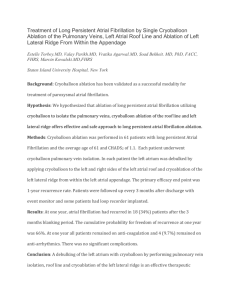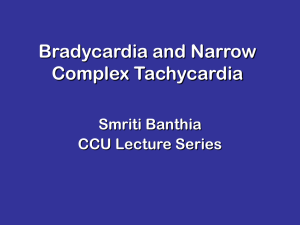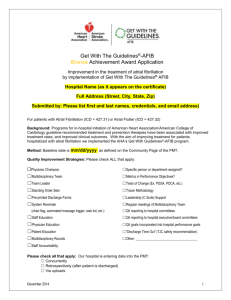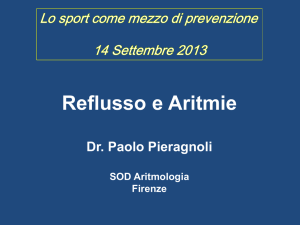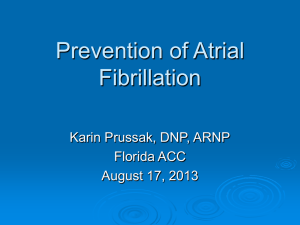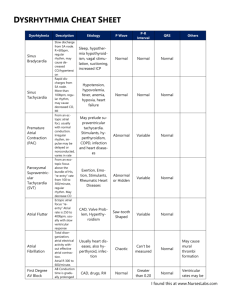Full paper
advertisement
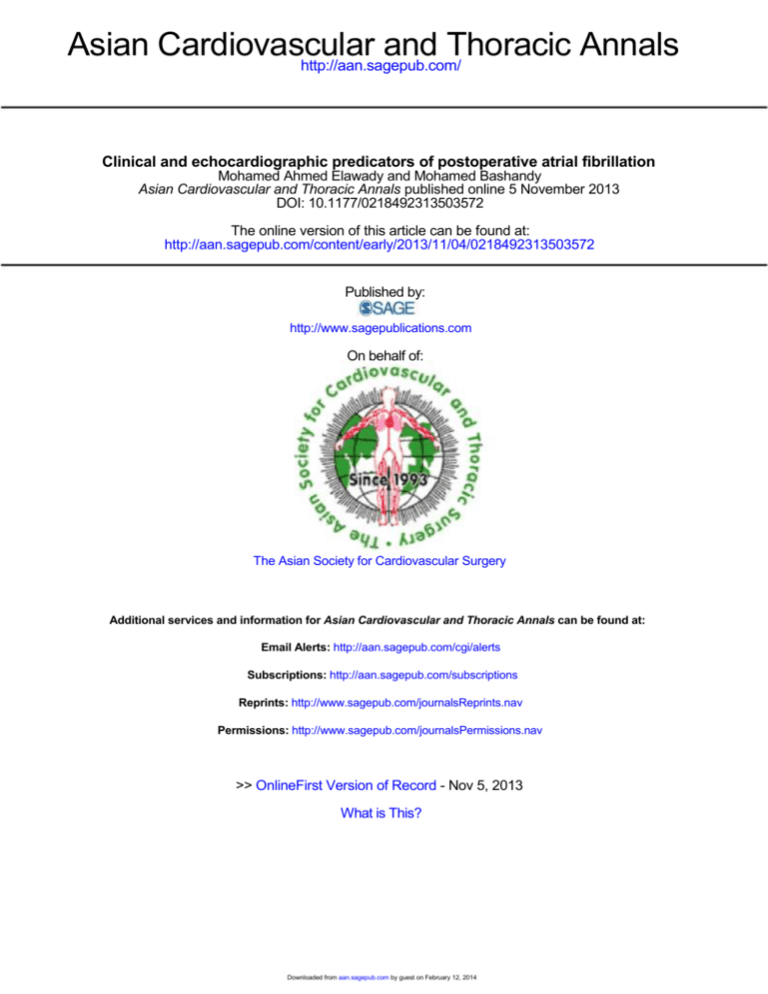
Asian Cardiovascular and Thoracic Annals http://aan.sagepub.com/ Clinical and echocardiographic predicators of postoperative atrial fibrillation Mohamed Ahmed Elawady and Mohamed Bashandy Asian Cardiovascular and Thoracic Annals published online 5 November 2013 DOI: 10.1177/0218492313503572 The online version of this article can be found at: http://aan.sagepub.com/content/early/2013/11/04/0218492313503572 Published by: http://www.sagepublications.com On behalf of: The Asian Society for Cardiovascular Surgery Additional services and information for Asian Cardiovascular and Thoracic Annals can be found at: Email Alerts: http://aan.sagepub.com/cgi/alerts Subscriptions: http://aan.sagepub.com/subscriptions Reprints: http://www.sagepub.com/journalsReprints.nav Permissions: http://www.sagepub.com/journalsPermissions.nav >> OnlineFirst Version of Record - Nov 5, 2013 What is This? Downloaded from aan.sagepub.com by guest on February 12, 2014 Original Article Asian Cardiovascular & Thoracic Annals 0(0) 1-5 ß The Author(s) 2013 Clinical and echocardiographic predicators of postoperative atrial fibrillation Reprints and permissions: sagepub.co.uk/journalsPermissions.nav DOI: 10.1177/0218492313503572 aan.sagepub.com Mohamed Ahmed Elawady1,2 and Mohamed Bashandy1,3 Abstract Background: Postoperative atrial fibrillation is the most common arrhythmia after coronary artery bypass grafting, with a reported incidence of 10% to 60%. Preoperative clinical and echocardiographic data, especially the atrial electromech- anical interval, predict postoperative atrial fibrillation in elective coronary artery bypass patients. Methods: A prospective study evaluated preoperative clinical and echocardiographic data in 192 patients who under- went elective coronary artery bypass from 2010 to 2012. Results: 18 (9.37%) patients developed postoperative atrial fibrillation. Compared to patients without postoperative atrial fibrillation, these 18 had significantly longer intensive care unit and hospital stays, they were significantly older (58.62 Æ 10.02 vs. 53.22 Æ 8.23 years; p ¼ 0.02), with a larger left atrial volume (83.39 Æ 8.31 vs. 55.47 Æ 8.37 cm3, p ¼ 0.001), longer atrial electromechanical interval (133.67 Æ 8.15 vs. 98.05 Æ 6.71 ms p < 0.0001), and lower tissue Doppler imaging systolic velocity wave amplitude (6.6 Æ 1 vs. 9.4 Æ 2.2 cmÁsÀ1; p ¼ 0.001); they also had a higher preva- lence of hypertension (61.11% vs. 38.5%; p ¼ 0.04). Using 115 ms as the cutoff value of atrial electromechanical interval enabled us to detect patients who developed postoperative atrial fibrillation with 100% sensitivity, 77% specificity, 78% positive predictive value, and 100% negative predictive value. Conclusion: Older hypertensive patients are at higher risk of developing postoperative atrial fibrillation. Preoperative measurement of atrial electromechanical interval by tissue Doppler echocardiography is a useful predictor of postoperative atrial fibrillation in coronary artery bypass patients. Keywords Atrial fibrillation, atrial function, left, blood flow velocity, coronary artery bypass, echocardiography, doppler Introduction Postoperative atrial fibrillation (POAF) is the most common arrhythmia after coronary artery bypass graft- ing (CABG), with a reported incidence of 10% to 60%.1-4 POAF is self-limiting in most cases, but even when uncomplicated, its treatment requires additional medical and nursing time. In a minority of cases, POAF is associated with thromboembolic complications and postoperative stroke, leading to longer intensive care unit and hospital stays and significantly increased costs.4,5 The onset of POAF in 70% of cases occurs during the first 4 postoperative days, and only 6% develop atrial fibrillation after the 6th day; 22% of these patients have 2 episodes of POAF.6 The exact pathophysiological mechanisms responsible for the onset and persistence of postoperative atrial arrhyth- mias are incompletely understood. Factors facilitating POAF can be classified as: acute factors directly related to surgery, such as adrenergic stimulation; and factors that reflect a chronic and progressive process of remodeling or ageing of the heart, such as left atrial enlargement.7 Risk factors for POAF include advanced Saud Al-Babtain Cardiac Center, Dammam, Saudi Arabia Cardiothoracic Surgery Department, Banha Faculty of Medicine, Banha University, Egypt 3 Cardiology Department, Faculty of Medicine, Alazhar University, Egypt 1 2 Corresponding author: Mohamed Ahmed Elawady, MD, Cardiothoracic Surgery Department, Banha Faculty of Medicine, Banha University, Banha 2344, Egypt. Email: mohamedawady@yahoo.com Downloaded from aan.sagepub.com by guest on February 12, 2014 2 Asian Cardiovascular & Thoracic Annals 0(0) age, male sex, low ejection fraction, hypertension, smoking, and diabetes mellitus. 8 As atrial contractile dysfunction may predict the development of POAF in patients undergoing CABG, measurement of preopera- tive atrial function may be useful to identify patients at increased risk of POAF.9 Doppler echocardiographic measurements of left atrial function, such as transmitral filling velocities and atrial filling fraction or atrial area changes by planimetry, failed to predict POAF because transmitral flow velocities are more dependent on the atrioventricular pressure gradient rather than atrial contractility only, and it is highly sensitive to changes in loading conditions.10 Tissue Doppler imaging, a rela- tively new technology, allows direct noninvasive measurements of myocardial velocities.11 Direct assessment of the mitral annular velocity during atrial systole by tissue Doppler imaging analysis has proved to be sen- sitive and reproducible for quantifying left atrial con- tractile function, and it reflects atrial contractile function better than transmitral atrial filling velocity, regardless of the severity of diastolic dysfunction. 12 Assessment of possible left atrial dysfunction in patients with coronary artery disease, by tissue Doppler echocardiographic imaging of the mitral annu- lus, especially measurement of the atrial electromechanical interval (AEMI) as a marker of atrial impairment, could be helpful in predicting those at risk of developing post-CABG atrial fibrillation.11,13 Patients and methods A prospective study was undertaken from May 2010 to May 2012 to assess preoperative clinical and echocardiographic data, especially AEMI, as predictors of POAF in elective CABG patients at Saud Babtain Cardiac Center. Inclusion criteria were elective CABG on conventional cardiopulmonary bypass, left ventricu- lar ejection fraction 535%, preoperative sinus rhythm and no history of atrial fibrillation. Exclusion criteria were age >70 years, history of atrial fibrillation, chronic obstructive pulmonary disease, poor left ven- tricular function, associated valvular heart disease, renal failure on regular dialysis, recent preoperative myocardial infarction (<1 month), emergency or urgent CABG, redo CABG, current use of antiarrhyth- mic drugs, of-pump CABG, and postoperative low cardiac output syndrome. There were 192 eligible patients enrolled in this study. From the day of admission until the day of discharge, all patients had a daily standard 12-lead electrocardio- gram (ECG). In the cardiovascular intensive care unit, POAF was detected using a Siemens SC 9000XL bedside arrhythmia monitor (Siemens Medical Systems, Danvers, MA, USA). Postoperatively, all patients were monitored in the ward by continuous ECG telemetry monitoring (Siemens). A 12-lead ECG was carried out if a patient had atrial fibrillation, and a second 12-lead ECG was obtained when they returned to sinus rhythm. All patients underwent preoperative transthoracic echocardiography with tissue Doppler imaging analysis (Vivid 7; GE Medical Systems, Vingmed, Norway). The left ventricular end-systolic and end-diastolic dimen- sions were obtained according to the recommendations of the American Society of Echocardiography, in para- sternal long-axis view with the M-mode cursor pos- itioned just beyond the mitral leaflet tips perpendicular to anteroseptal and posterior left ven- tricular walls. Left atrial volume was determined by the biplane area-length method, tracing the endocar- dium and measuring the vertical axis of the left atrium in apical 4- and 2-chamber views at the maximal atrial dimension. The left ventricular ejection fraction was assessed in 2-dimensional echocardiography by the modified biplane Simpson method in apical 4- and 2-chamber views. The A wave (late atrial filling vel- ocity) was measured using pulsed-wave Doppler across the mitral valve in apical 4-chamber view with the line parallel to the flow and the sample volume at the tip of the mitral valve leaflets; an average of 3 con- secutive cardiac cycles was obtained. The tissue Doppler property was activated to obtain myocardial velocities, Am wave (peak velocity during atrial systole) and AEMI (time interval from the onset of the P wave in the surface ECG to the beginning of atrial systole) were measured as the average of 3 cardiac cycles with the 3-mm sample volume placed at the lateral mitral annulus in apical 4-chamber view. All patients continued on their usual drugs including aspirin until the morning of surgery, but clopidogrel was stopped at least 5 days before surgery. All patients had a midline sternotomy. The left internal mammary artery was harvested and skeletonized. All operations were performed using a conventional cardiopulmonary bypass machine with crossclamping of the aorta, and antegrade cold blood cardioplegic solution was given every 20 minutes. Cardiopulmonary bypass was con- ducted using a membrane oxygenator and mild hypo- thermia (351C). All demographic data, preoperative, operative and postoperative data were collected, and statistical ana- lysis was conducted using SPSS version 18.0 software (SPSS, Inc., Chicago, IL, USA). Values of continuous variables are expressed as mean Æ standard deviation, and categorical variables are expressed as numbers and percentages. The studied variables were assessed by uni- variate analysis. Continuous variables were compared using the unpaired t test, and the chi-square test was used to compare categorical variables. The best cutof point for the AEMI to predict the possibility of POAF Downloaded from aan.sagepub.com by guest on February 12, 2014 Elawady and Bashandy 3 Discussion was defined by receiver-operating characteristic curve analysis. A p value less than 0.05 was considered statistically significant. Results Eighteen (9.37%) patients developed POAF during hospital stay (group 1) and 174 (90.63%) did not develop POAF (group 2). All patients in group 1 suc- cessfully reverted to sinus rhythm. Patients in group 1 were significantly older than those in group 2, and the prevalence of hypertension was significantly higher in group 1 (Table 1). Table 2 shows the preoperative echo- cardiographic parameters of both groups. Patients in group 1 had a significantly larger mean left atrial volume, lower tissue Doppler imaging mean A m wave amplitude, and longer AEMI, but there were no statistically significant diferences between the 2 groups in terms of left ventricular ejection fraction, left ventricu- lar endsystolic and end-diastolic dimensions, or trans- mitral A wave amplitude. This study demonstrated that the use of preoperative AEMI derived by Doppler tissue imaging as a reflection of intraatrial conduction was useful in predicting the development of POAF in CABG patients, with a cutof value of 115 ms which carries a specificity of 77%, a sensitivity of 100%, a positive predictive value of 78%, and a negative pre- dictive value of 100%. There were no significant difer- ences in operative data between groups, but the mean intensive care unit and hospital stays were significantly longer in group 1 (Table 3). Table 1. Preoperative demographic data and clinical status of patients undergoing coronary artery bypass, according to the development of postoperative atrial fibrillation. Variable Group 1 (n ¼ 18) Group 2 (n ¼ 174) p value Mean age (years) Male 58.62 Æ 10.02 15 (83.33%) 53.22 Æ 8.23 153 (87.93%) 0.02 0.37 3 (16.67%) 21 (12.07%) 0.48 11 (61.11%) 67 (38.5%) 0.04 7 (38.89%) 70 (40.23%) 14 (77.78%) 6 (33.33%) Female Hypertension Diabetes mellitus Dyslipidemia Smoker Group 1 (n ¼ 18) Group 2 (n ¼ 174) p value 0.68 LV ejection fraction Atrial volume (cm3) 43.83% Æ 6.55% 83.39 Æ 8.31 47.09%Æ8.9% 55.47 Æ 8.37 0.13 <0.001 142 (81.61%) 0.69 A wave (cmÁsÀ1) 49 (28.16%) 0.84 12 (66.67%) 98 (56.32%) 0.26 Beta blocker 15 (83.33%) 154 (88.51%) 0.46 ACE inhibitor 9 (50%) 84 (48.28%) 0.7 Calcium channel blocker 5 (27.78%) 51 (29.31%) 0.8 16 (88.89%) 148 (85.06%) 0.9 ACE: angiotensin-converting enzyme. Table 2. Preoperative echocardiographic parameters according to the development of postoperative atrial fibrillation. Variable Old myocardial infarction Lipid lowering drugs Post-CABG atrial fibrillation is associated with higher morbidity and mortality rates.1-4 Perioperative administration of antiarrhythmic drugs, especially amiodar- one intravenously and orally, was found to be efective in reducing the incidence of POAF in patients undergo- ing CABG, but it has many side efects, so it is wise to give it as a prophylactic measure to certain groups of patients with higher risk of POAF.14 Many studies have attempted to recognize risk factors for POAF, concen- trating mainly on preoperative echocardiographic par- ameters. Older age and poor left ventricular function are considered the most important risk factors for POAF;6,7,11,15-19 but other risk factors including dia- betes, hypertension, dyslipidemia, and smoking have given conflicting results.18 Some studies have focused on preoperative AEMI derived by Doppler tissue imaging as a predictor of POAF. 15-19 In our study, although the incidence of POAF was greater in men, there was no significant sex diference between groups, which has been a matter of debate in some studies.16,18 Our POAF patients were older and had a greater prevalence of hypertension than non- POAF patients, which is similar to the findings of other studies which concluded that POAF is more common in hypertensive patients, 4-8 and those who developed POAF were significantly older.15,16,18,19 This can be explained by more atrial fibrosis, conduct- ive tissue abnormality, and muscle atrophy, which occur with advanced age.17 In our study, diabetes, smoking, and dyslipidemia were not considered dependant risk factors for POAF, which is similar to many studies on diabetes as a risk factor for POAF.6,7,15-19 We found no diference between the 2 groups regarding the use of preoperative drugs such as beta blockers, angiotensinconverting enzyme inhibi- tors, calcium antagonists, or lipid lowering agents, in agreement with previous findings.11,18,20 AEMI (ms) Am wave (cmÁsÀ1) 39.6 Æ 1.8 133.67 Æ 8.15 41.2 Æ 4.4 0.12 98.05 Æ 6.71 <0.0001 6.6Æ1 9.4Æ 2.2 0.001 LVEDD (cm) 5.24 Æ 0.7 5.02 Æ 0.89 0.64 LVESD (cm) 3.74 Æ 0.67 3.63 Æ 0.87 0.78 AEMI: atrial electromechanical interval; Am wave: peak velocity during atrial systole; LV: left ventricular; LVEDD: left ventricular end-diastolic dimension; LVESD: left ventricular end-systolic dimension. Downloaded from aan.sagepub.com by guest on February 12, 2014 4 Asian Cardiovascular & Thoracic Annals 0(0) Group 1 (n ¼ 18) Group 2 (n ¼ 174) p value CABG patients. The use of 115 ms as a cutof value of AEMI can detect POAF in CABG patients with 77% specificity, 100% sensitivity, 78% positive predictive value, and 100% negative predictive value. 71.28 Æ 20.31 69.68 Æ 18.97 0.15 Funding 47.66 Æ 13.0 45.96 Æ 14.3 0.59 This research received no specific grant from any funding agency in the public, commerical, or not-for-profit sectors. 3.1 Æ 0.6 2.9 Æ 0.6 0.41 48.7 Æ 11.3 26.9 Æ 3.9 0.001 9.46 Æ 1.1 7.76 Æ 0.8 0.007 Table 3. Perioperative data according to the development of postoperative atrial fibrillation. Variable Cardiopulmonary bypass (min) Crossclamping (min) No. of grafts Intensive care unit stay (h) Hospital stay (days) Conflict of interest statement None declared References Although only patients with good left ventricular function were included in our study, the preoperative left ventricular ejection fraction in patients who devel- oped POAF was lower but not significantly diferent between the 2 groups, as reported by Ac¸il and col- leagues20 but some other studies noted significantly lower preoperative left ventricular ejection fraction in patients who developed POAF.11-17 Patients who devel- oped POAF had significantly larger left atrial volumes than those without POAF, as found by Ac¸il and col- leagues,20 which can be explained by increased atrial muscle, shortening of the refractory period, and pro- longation of atrial conduction time. Our study demon- strated that preoperative AEMI was longer in patients who developed POAF than those who maintained sinus rhythm postoperatively (133.67 Æ 8.15 vs. 98.05 Æ 6.71 ms, respectively; p < 0.0001); these data are similar to the findings of Roshanali and colleagues11 who used tissue Doppler imaging-derived AEMI as a predictor of POAF in isolated CABG. In our study, the cutof value of AEMI 115 ms was selected with 100% sensitivity so it detected all patients who developed POAF; similarly, Roshanali and colleagues11 used 120 ms as a cutof value of AEMI that yielded 100% sensitivity, 94.8% specificity, 81.9% positive predictive value, and 100% negative predictive value for the pre- diction of POAF. We cannot separate the prolongation of AEMI from the other left atrial echocardiographic parameters, especially left atrial volume. AEMI may be secondary to increased left atrial volume, and further clinical studies are needed comparing AEMI in patients with POAF with a control group that matches the POAF group in left atrial volume to detect whether AEMI is secondary to increased left atrial volume. Further studies are also needed to evaluate AEMI as a primary risk factor for predication of POAF, and development of a scoring system to predict POAF, especially in high-risk patients. We concluded that older age and hypertension increase the risk of develop- ing POAF after CABG. Preoperative tissue Doppler- derived AEMI is a useful predictor of POAF in 1. Villareal RP, Hariharan R, Liu BC, et al. Postoperative atrial fibrillation and mortality after coronary artery bypass surgery. J Am Coll Cardiol 2004; 43: 742-748. 2. Hakala T, Hedman A, Turpeinen A, Kettunen R, Vuolteenaho O and Hippela¨inen M. Prediction of atrial fibrillation after coronary artery bypass grafting by mea- suring atrial peptide levels and preoperative atrial dimen- sions. Eur J Cardiothorac Surg 2002; 22: 939-943. 3. Zangrillo A, Landoni G, Sparicio D, et al. Predictors of atrial fibrillation after off-pump coronary artery bypass graft surgery. J Cardiothorac Vasc Anesth 2004; 18: 704-708. 4. Shen J, Lall S, Zheng V, Buckley P, Damiano RJ Jr and Schuessler RB. The persistent problem of new-onset postoperative atrial fibrillation: a single-institution experience over two decades. J Thorac Cardiovasc Surg 2011; 141: 559-570. 5. Hravnak M, Hoffman LA, Saul MI, Zullo TG, Whitman GR and Griffith BP. Predictors and impact of atrial fibrillation after isolated coronary bypass grafting. Crit Care Med 2002; 30: 330-337. 6. Auer J, Weber T, Berent R, Ng CK, Lamm G and Eber B. Risk factors of postoperative atrial fibrillation after cardiac surgery. J Card Surg 2005; 20: 425-431. 7. Mathew JP, Fontes ML, Tudor IC, et al. A multicenter risk index for atrial fibrillation after cardiac surgery. JAMA 2004; 291: 1720-1729. 8. Mitchell LB, Crystal E, Heilbron B and Page´ P. Atrial fibrillation following cardiac surgery. Can J Cardiol 2005; 21(Suppl B): 45B-50B. 9. Haffajee JA, Lee Y, Alsheikh-Ali AA, Kuvin JT, Pandian NG and Patel AR. Pre-operative left atrial mechanical function predicts risk of atrial fibrillation following car- diac surgery. JACC Cardiovasc Imaging 2011; 4: 833-840. 10. Hesse B, Schuele SU, Thamilarsan M, Thomas J and Rodriguez L. A rapid method to quantify left atrial func- tion: Doppler tissue imaging of the mitral annulus during atrial systole. Eur J Echocardiogr 2004; 5: 86-92. 11. Roshanali F, Mandegar MH, Yousefnia MA, Rayatzadeh H, Alaeddini F and Amouzadeh F. Prediction of atrial fibrillation via atrial electromechan- ical interval after coronary artery bypass grafting. Circulation 2007; 116: 20122017. 12. Omi W, Nagai H, Takamura M, et al. Doppler tissue analysis of atrial electromechanical coupling in Downloaded from aan.sagepub.com by guest on February 12, 2014 Elawady and Bashandy 13. 14. 15. 16. 5 paroxysmal atrial fibrillation. J Am Soc Echocardiogr 39-44. Yu CM, Fung JW, Zhang Q, et al. Tissue Doppler echocardiographic evidence of atrial mechanical dysfunction in coronary artery disease. Int J Cardiol 2005; 105: 178-185. Koniari I, Apostolakis E, Rogkakou C, Baikoussis NG and Dougenis D. Pharmacologic prophylaxis for atrial fibrillation following cardiac surgery: a systematic review. J Cardiothorac Surg 2010; 5: 121-130. Zaman AG, Archbold RA, Helft G, Paul EA, Curzen NP and Mills PG. Atrial fibrillation after coronary artery bypass surgery a model for preoperative risk stratifica- tion. Circulation 2000; 101: 1403-1408. Roshanali F, Mandegar MH, Yousefnia MA, Alaeddini F and Saidi B. Prevention of atrial fibrillation after cor- onary artery bypass grafting via atrial electromechanical 17. 18. 19. 20. interval and use of amiodarone prophylaxis. Interact 2005; 18: Cardiovasc Thorac Surg 2009; 8: 421-425. Hakala T, Pitka¨nen O and Hippela¨inen M. Feasibility of predicting the risk of atrial fibrillation after coronary artery bypass surgery with logistic regression model. Scand J Surg 2002; 91: 339-344. Iribarren JL, Jime´nez JJ, Barraga´n A, et al. Left atrial dysfunction and new-onset atrial fibrillation after cardiac surgery. Rev Esp Cardiol 2009; 62: 774-780. Hakala T and Hedman A. Predicting the risk of atrial fibrillation after coronary artery bypass surgery. Scand Cardiovasc J 2003; 37: 309-315. Ac¸il T, Co¨lkesen Y, Tu¨rko¨z R, et al. Value of preoperative echocardiography in the prediction of postoperative atrial fibrillation following isolated coronary artery bypass grafting. Am J Cardiol 2007; 100: 1383-1386. Downloaded from aan.sagepub.com by guest on February 12, 2014
